Published 8 August 2020 ● Last Updated on 10 August 2020
Our world faces a food paradox. On the one hand, 1 in 9 people globally are undernourished; on the other hand, our food systems lose and waste 1/3rd of all that is produced. Or consider this: we in Singapore import 90% of our food needs; and yet, a large pile of “trash” in our national bin is food waste! While we need to fix systemic issues to address these challenges, equally, we need to eliminate food waste from our plates.
In our search for practical ways to reduce food waste at home, we met Vyshnavi Doss – a freestyle home cook who shares vegetarian and zero waste cooking ideas on Instagram at @vyshdoss. A jewellery designer by profession, Vyshnavi loves tropical flavours and inspirations, and often experiments with foods and recipes. Here, in her own words, are tried-and-tested tips to run a kitchen with a minimal waste.
Among the less vexing of challenges brought on by the Covid lockdowns was the self-imposed assignment to take my home cooking up a few notches amidst supply chains gone awry. Groceries and fresh produce were appearing and disappearing unpredictably, and familiar brands were replaced with new ones packed in proportions we were unaccustomed to. To add to our life’s struggles, we had started eating more indulgently for want of entertainment. This was the start of my journey in zero-waste cooking – an aim that we consume all the food we buy, and eliminate waste completely.
I wanted to make good meals by maximising the use of whatever I had at hand. But clever inventory management practices soon turned into exploratory routines that were not just rewarding but also treated ingredients with honour. Zero-waste cooking is a small but significant addition to the everyday choices we’ve been making towards a greener lifestyle. We are a family of two living in an apartment and we don’t see ourselves composting or going freegan. Even so, there are many ways to reduce our “foodprint” and I am sharing 5 of the most impactful ones below:
#1 Ditching the rubbish chute for rabbit holes
Basics first, and this is about the value of an online search. Before tossing anything, I ask the ever omniscient one. Can I use wilted spinach? Can I eat cauliflower greens? What do I do with papaya seeds? How do you cook without waste? The Internet engineers a joyride of discoveries and endless possibilities.
In one of my recent www-assisted conquests I got the better of a large opened packet of heavy cream threatening to spoil (or so I thought). After skimming through entries on the brilliance of soured milk and cream I stumbled upon a gem with the help of which I made butter, a pot of ghee, and with the residual buttermilk, a small batch of cottage cheese. The caramel-like dregs from the ghee making process were spooned over curries and rice over the next few days. Win!
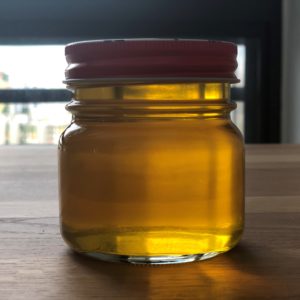
Watermelon rinds were recently having a moment in some Instagram circles. I happened to have a wedge in the fridge, so I entered my query in the search field. The reveal was a legion of soups, desserts, stews and jams. I won’t be throwing watermelon rinds ever again.
Perishables can be preserved. Pickling has the workings of a passion project on its own, and cyberspace is littered with posts on how to start. I made a novice-level instant pickle with daikon radish to snack on, preferably with a glass of sake.
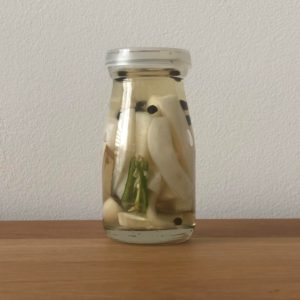
#2 Expanding the palate, shrinking the waste
Food waste can be a portal to culture and history. Societies have optimised available raw material in the face of war, famine, invasions, social stratification and seasonal cycles. Sometimes the best solutions to reduce food waste can be found in communities and times that aren’t our own. At home, we sometimes cook and eat in ways that are new to us. It is a nice stretch for the mind and the palate while reducing waste.
One particular kitchen caper involved jackfruit seeds. Who knew they could be roasted, that once boiled, their creamy comfort is something to be relished? Several folks around the world did, apparently, including the Thais and South Indians who grew up sharing space with jackfruit trees. I found a Konkani curry that calls for the very seeds I would’ve thrown away; soon I was using pantry staples in a novel way to make a masala-paste while trying to wrap my head around various Konkani communities and their cooking practices.
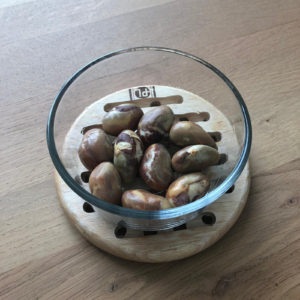
#3 Inventory-first cooking
I enjoy chasing the myth of authenticity. But I mostly like to think of dishes as friendly beings that will gladly accommodate tweaks, leftovers and unorthodox ingredients. Every dish is a framework – a medium to utilise inventory and imagination to reduce waste.
As the world sought comfort in bread and desserts during the circuit breaker, baking essentials were hard to come by. I was forced to look at my own pantry with fresh eyes when I was unable to source flour to make shortbread cookies. The payoff was fabulous: a set of redeeming cookies prepared with millet flour and amaranth seed flour and an experimental batch of curd that didn’t set perfectly (look for the recipe at the end of this post). In fact they turned out so well that I distributed the excess among friends – a feel-good way to reduce food waste that I resort to even with groceries.

A godsend to our flour-starved, cake craving times was the Peranakan sugee cake, which calls for the Indian pantry staple, semolina. But once again, save for semolina, I didn’t have all the requisite raw materials. I negotiated the classic recipe with a discretionary skipping of almond flour, brandy and plain flour and by throwing in the good stuff I had at home: cardamom and a few pods jackfruit that needed to be used up. One-upping the supply chain never tasted better.
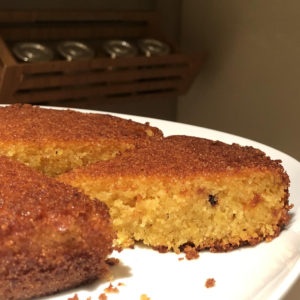
#4 Looking beyond “best before”, “spoiled” and “unusable”
Ingredients have souls that go beyond their designated roles and best before dates. I try to use my senses instead of labels to understand them better. Spices for instance, lose some potency after their best before date, but they will last fairly long before they become useless. “Good enough” will suffice unless I’m fixing a special meal.
Things we label as “spoiled” or “unusable” are often serviceable in other edible ways. Back at my home in India, we always picked tender green ivy gourds for our stir fry and scrapped the ripe, fruity ones with red innards. The thumb rule recently came into question when we ended up with a big bunch of mature gourds from Little India. A marvel of a recipe called for these culinary rejects and transformed them into a gorgeous South Indian relish.
A little research can tell us how better to deal with leftover wine than to throw it away. What is unsuitable for drinking may be used in risottos, soups or sauces, to make vinegar, or frozen to make mulled wine when the season demands it.
#5 Discards are delicious, but the body is not a rubbish chute
Some peels are glorious – like orange peels which can be used to make marmalade; I make an Indian relish with it. Cilantro stems are flavour powerhouses and some Asian recipes will use roots as well. Bandwidth permitting, I collect a day’s worth of vegetable peels and seeds to cook Indian condiments that can be bottled for up to a week. They also lend themselves to soups and pasta sauces, or could be seasoned and baked crisp for snacking. But here is the thing: zero-waste is a goal to strive towards, not an ultimatum. Not all discards can be processed well by the body. My gustatory romance with a medley of cauliflower stems, radish greens and beet greens was one that my stomach regretted immensely. If you are cooking with discards, I would urge you to proceed sensibly and carefully. Please research online and start with a small sample. Many vegetables and fruits are fully edible and can be elevated to beautiful dishes. We just need to know how to prep them, cook them and how much of them we can take.
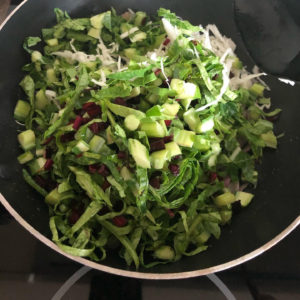
My journey into sustainable cooking may be in its beginnings – but already I feel this isn’t just a “zero waste cooking trend”; it is the embracing of a larger zero waste concept. What is zero waste cooking to you? Do my recipes for a more eco kitchen appeal to you? Let me tempt you further with a recipe! And do leave your thoughts, feedback, suggestions in the comments below!
RECIPE | Spiced shortbread cookies with pantry staples
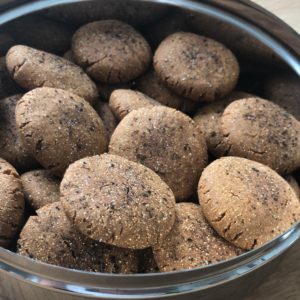
This is a fun and forgiving recipe that can be made with any flour you have in stock or a combination of them. The basic flour/s-to-fat proportion is 1:1/3. You may use melted butter or ghee. Feel free to go wild with flavours by using the spices and herbs you have at home.
This recipe yields about 40 biscuits.
Ingredients:
- Sorghum flour: 200g
- Amaranth seed flour: 100g
- Ghee or melted butter at room temperature: 100g
- Curd or yoghurt: 2 tablespoons
- Baking soda: 1 teaspoon
- Flaxseed powder: 1 tablespoon (optional)
- Cumin seeds: 2 teaspoons
- Jaggery or sugar: 1 teaspoon
- 1 medium-sized onion, finely chopped
- 2 green chillies, finely chopped
- 2” ginger, skinned and grated
- Salt to taste
Method:
- Sift flours and baking soda into a mixing bowl.
- Add all ingredients except the fat and the curd (or yoghurt).
- Blend all ingredients with a spoon to form an even mixture.
- Make a well in the centre and pour in the fat (melted, but at room temperature).
- Use hand to incorporate the fat evenly.
- Add the curd (or yoghurt) and knead everything into a stiff, smooth and slightly greasy dough. (If it is too dry, spoon in a little more fat and yoghurt and knead well. If it is too wet, sprinkle a little more flour and knead till you achieve the desired consistency).
- Allow the dough to rest for 1/2 an hour.
- Preheat oven to 160 C and line a baking tray with baking paper.
- Roll the dough into calamansi-sized balls, flatten them between your palms and arrange them on the tray.
- Bake them for 20-25 minutes.
- Flip the biscuits and bake them for another 20 minutes.
- At the end of 20 minutes, break one of them in half to test for doneness. If the centre looks soft and moist, bake them for another 10 minutes or till the centre is crumbly.
— Vyshnavi Doss is an independent jewellery designer and freestyle vegetarian home cook who loves tropical flavours and inspirations. Her experiments with home cooking can be found on Instagram at @vyshdoss and her experiments with jewellery at @design_by_dvibhumi
All photographs used in the article belong to the author.
Related Articles:
Sustainable Singapore | Your role in making our Little Red Dot food secure
Zero Waste Bootcamp| Combating food waste at the grassroots in Singapore



0 Comments